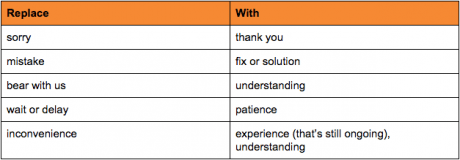It’s much easier and less disrupting for someone to go a company’s social profile to ask a question than it is to wait on the phone for an answer or even Google it. That’s why customer service needs to be a part of any company’s social media strategy. These are the seven most important best practices in social customer service—and why your business will suffer without them.
Best Practice #7: Keep a Level Head
Especially for business owners, there’s always a degree of emotional attachment and it can get the best of you sometimes. Keep your cool no matter what and you’ll look like the better person to onlookers. There is such a thing as bad press when one negative comment on Twitter or Facebook can lose 30 customers. The good news: turning it around helps because 71% of people who have a positive social customer service interaction are likely to recommend that brand to others (up from 19% who don’t receive a response at all).
There are two major ways to prepare yourself for this:
- The best offense is a good defense. Realistically plan (at least in your head) for the worst questions and comments imaginable and arm yourself with practice responses for each. Strategize where to direct people with different issues and keep it short in length (but not in tone).
- Build an engaged, passionate community. They will rally around you when you’ve been wronged, I see it happen all the time. The catch is that in order to build the community, you have to already be implementing social customer service and community management best practices.
Just remember: there are no stupid questions. If it’s important to them it must, in turn, be important to you (even when the question actually is stupid).
Best Practice #6: Positivity
You can admit that you’ve messed up without using the word “sorry.” Save that for the worst offenses that won’t get better without majorly kissing butt. Instead, craft sentences that are upbeat and optimistic.

Examples:
- Thank you for bringing this to our attention!
- Oh geez, that’s embarrassing. Thanks for being so understanding!
- Thank you for your patience while we fix this!
Best Practice #5: You’re a Person, I’m a Person
Canned answers are the worst. I don’t have statistics for that because experience shows I don’t need any. Scripts, copy+paste formulas and corporate speak make customer experience more like snoozefests. So, unless you’re a self-deprecating mattress company, stay away from these offputting (albeit time-saving) practices.
Instead, inject your brand’s personality into and personalize every response as much as possible. In most cases, that means more than just greeting them by name because that no longer feels special when their name is literally right in front of you.
Depending on your brand’s established voice, you can:
- validate their feelings
- re-state their question to prove you understood it
- use their terminology (if correct)
- take a peek at their profile to see their interests and incorporate them into your answer
- use puns, memes or emojis
- add their question to the FAQ section (and thank them for it)
Best Practice #4: The extra mile shouldn’t feel extra to you
Saving customers time builds trust and just makes their day that much easier. It could be as simple as Googling an answer, linking them to a specific page or talking to another department for them instead of handing out a phone number. It could be as big as hunting down an order, providing an answer or service that’s not actually offered by your business or getting the higher-ups to make an exception for their situation. The effort will be worth it.
Best Practice #3: Timeliness
The fastest way to lose a customer is to be slow. You don’t answer quick enough and they’re off to a competitor.
Unfortunately, social media users have high standards. Thirty-two percent of Twitter users expect a response within 30 minutes, and more than 80% expect one within 24 hours. On Facebook, more than 50% expect the same 24-hour turnaround.
If you don’t have the answer right away (or at all), follow these steps:
- acknowledge them so they know they’re not being ignored
- let them know an honest time frame and, if they aren’t impressed by the delay, be honest about why that’s the way it is
- keep them in the loop
- be sure to follow up ASAP
Best Practice #2: Accuracy
Self-explanatory, yes?
Just in case it’s not:
When someone asks a question, they’re looking for a helpful answer. 80% of companies believe they deliver quality customer service, but that can’t be true when only 8% of consumers believe the same. Yikes. There’s an obvious disconnect and, I hate to say it, companies are the ones who are wrong. Evaluate your customer service standards and make sure they’re set according to customers’ expectations and needs.
Best Practice #1: Relevancy
None of the others matter without this one. No one will care how fast or well you said something if it doesn’t answer their question.
Additionally, do not waste anyone’s time by providing anything that’s not related to their answer. Ain’t nobody got time for a long-winded tangent about your business.
Whether a community manager or a separate team handles social customer service, these seven best practices offer indisputable benefits to your business. No matter what’s thrown your way, make sure the customer comes first and leaves any situation with a positive experience.
Do you have a nightmare or exceptional social customer experience to share?


Leave a Reply